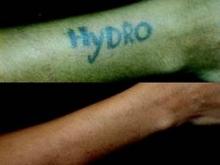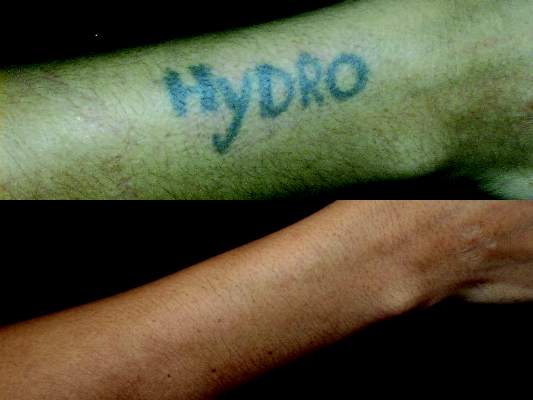User login
NEW ORLEANS – Laser tattoo removal using a 3-week interval between treatments may be feasible for most patients, based on data from a pilot study conducted by Dr. Robert Burke.
The demand for tattoo removal has increased along with tattoo prevalence in the United States, Dr. Burke said at the annual meeting of the American Academy of Cosmetic Surgery. The treatment protocol for laser tattoo removal depends on the patient’s skin type, as well as on the type and density of inks used, said Dr. Burke, founder and director of the Michigan Center for Cosmetic Surgery in Ann Arbor.
Some methods have been tested to accelerate the laser tattoo removal process, but have resulted in skin damage such as scarring and hypopigmentation, he added.
No standard recommendation currently exists for time intervals between laser tattoo removal treatments, Dr. Burke said. Intervals of 3, 4, 6, and 8 weeks or longer have been recommended. “It has been speculated that 3-week intervals can interfere with macrophage activity, but long-term studies have shown no clinical or other interference whether you treat at 3, 4, 6, or 8 weeks,” he said.
Previous recommendations were based mainly on tissue reactions observed with older lasers; this thermal damage was likely because of laser beam irregularities and nonuniform energy application in round beam lasers, he added.
Laser tattoo removal involves selective photothermolysis, Dr. Burke noted, and the laser light can destroy the target without damaging the surrounding tissue only if the thermal relaxation time (defined as the time necessary for the target to cool 50% through diffusion of heat to surrounding tissues) is greater than the pulse duration. “Fluence sufficient to reach a damaging temperature in target chromophores without damaging surrounding tissue structures is the critical element of selective photothermolysis,” he explained.
The study involved the treatment of nine tattoos on seven adults (two women and five men) with an average age of 33 years. The tattoos were of all treatable colors including black, blue-green, and red-yellow-orange.
Dr. Burke used a laser with three wavelengths that included Q-switched Nd:YAG and true ruby lasers. The laser’s square beam with a uniform power distribution is designed to decrease thermal damage to the uninvolved surrounding tissue. “I looked specifically into doing this pilot study after I saw this new laser,” he said. Laser beam selection was based on the major tattoo colors observed on the day of treatment, and wavelengths of 1,064-nm, 694-nm, and 532-nm with a consistent 3-mm spot size were used. Dark colors were treated first, followed by blue-green. Red was treated in the same session as the other colors only if the red areas were well defined, separate, and distinct in location; otherwise they were treated in subsequent sessions. The patients underwent an average of 3.5 treatments, with an average of 22 days between each treatment. The majority of patients responded favorably to the 3-week treatment interval, and there were no significant adverse effects. The tattoos continued to clear throughout the study period, and all patients reported satisfaction with their treatments, although the tattoos had not completely cleared by the end of the study period, Dr. Burke said.
One minor, self-limiting, increased healing interval occurred in a patient with a red tattoo treated with a 532-nm wavelength. “Interestingly enough, in this case, the red tattoo cleared completely after one treatment,” he added. A 3-week interval between treatments could result in more rapid tattoo removal, shortening the overall treatment time by 63%, compared with the existing average treatment time, Dr. Burke said. The treatment interval may be adjusted upward if skin requires a longer healing time following a particular treatment, he added, although larger, statistically valid studies are needed to support the results.
Dr. Burke reported no relevant financial disclosures.
NEW ORLEANS – Laser tattoo removal using a 3-week interval between treatments may be feasible for most patients, based on data from a pilot study conducted by Dr. Robert Burke.
The demand for tattoo removal has increased along with tattoo prevalence in the United States, Dr. Burke said at the annual meeting of the American Academy of Cosmetic Surgery. The treatment protocol for laser tattoo removal depends on the patient’s skin type, as well as on the type and density of inks used, said Dr. Burke, founder and director of the Michigan Center for Cosmetic Surgery in Ann Arbor.
Some methods have been tested to accelerate the laser tattoo removal process, but have resulted in skin damage such as scarring and hypopigmentation, he added.
No standard recommendation currently exists for time intervals between laser tattoo removal treatments, Dr. Burke said. Intervals of 3, 4, 6, and 8 weeks or longer have been recommended. “It has been speculated that 3-week intervals can interfere with macrophage activity, but long-term studies have shown no clinical or other interference whether you treat at 3, 4, 6, or 8 weeks,” he said.
Previous recommendations were based mainly on tissue reactions observed with older lasers; this thermal damage was likely because of laser beam irregularities and nonuniform energy application in round beam lasers, he added.
Laser tattoo removal involves selective photothermolysis, Dr. Burke noted, and the laser light can destroy the target without damaging the surrounding tissue only if the thermal relaxation time (defined as the time necessary for the target to cool 50% through diffusion of heat to surrounding tissues) is greater than the pulse duration. “Fluence sufficient to reach a damaging temperature in target chromophores without damaging surrounding tissue structures is the critical element of selective photothermolysis,” he explained.
The study involved the treatment of nine tattoos on seven adults (two women and five men) with an average age of 33 years. The tattoos were of all treatable colors including black, blue-green, and red-yellow-orange.
Dr. Burke used a laser with three wavelengths that included Q-switched Nd:YAG and true ruby lasers. The laser’s square beam with a uniform power distribution is designed to decrease thermal damage to the uninvolved surrounding tissue. “I looked specifically into doing this pilot study after I saw this new laser,” he said. Laser beam selection was based on the major tattoo colors observed on the day of treatment, and wavelengths of 1,064-nm, 694-nm, and 532-nm with a consistent 3-mm spot size were used. Dark colors were treated first, followed by blue-green. Red was treated in the same session as the other colors only if the red areas were well defined, separate, and distinct in location; otherwise they were treated in subsequent sessions. The patients underwent an average of 3.5 treatments, with an average of 22 days between each treatment. The majority of patients responded favorably to the 3-week treatment interval, and there were no significant adverse effects. The tattoos continued to clear throughout the study period, and all patients reported satisfaction with their treatments, although the tattoos had not completely cleared by the end of the study period, Dr. Burke said.
One minor, self-limiting, increased healing interval occurred in a patient with a red tattoo treated with a 532-nm wavelength. “Interestingly enough, in this case, the red tattoo cleared completely after one treatment,” he added. A 3-week interval between treatments could result in more rapid tattoo removal, shortening the overall treatment time by 63%, compared with the existing average treatment time, Dr. Burke said. The treatment interval may be adjusted upward if skin requires a longer healing time following a particular treatment, he added, although larger, statistically valid studies are needed to support the results.
Dr. Burke reported no relevant financial disclosures.
NEW ORLEANS – Laser tattoo removal using a 3-week interval between treatments may be feasible for most patients, based on data from a pilot study conducted by Dr. Robert Burke.
The demand for tattoo removal has increased along with tattoo prevalence in the United States, Dr. Burke said at the annual meeting of the American Academy of Cosmetic Surgery. The treatment protocol for laser tattoo removal depends on the patient’s skin type, as well as on the type and density of inks used, said Dr. Burke, founder and director of the Michigan Center for Cosmetic Surgery in Ann Arbor.
Some methods have been tested to accelerate the laser tattoo removal process, but have resulted in skin damage such as scarring and hypopigmentation, he added.
No standard recommendation currently exists for time intervals between laser tattoo removal treatments, Dr. Burke said. Intervals of 3, 4, 6, and 8 weeks or longer have been recommended. “It has been speculated that 3-week intervals can interfere with macrophage activity, but long-term studies have shown no clinical or other interference whether you treat at 3, 4, 6, or 8 weeks,” he said.
Previous recommendations were based mainly on tissue reactions observed with older lasers; this thermal damage was likely because of laser beam irregularities and nonuniform energy application in round beam lasers, he added.
Laser tattoo removal involves selective photothermolysis, Dr. Burke noted, and the laser light can destroy the target without damaging the surrounding tissue only if the thermal relaxation time (defined as the time necessary for the target to cool 50% through diffusion of heat to surrounding tissues) is greater than the pulse duration. “Fluence sufficient to reach a damaging temperature in target chromophores without damaging surrounding tissue structures is the critical element of selective photothermolysis,” he explained.
The study involved the treatment of nine tattoos on seven adults (two women and five men) with an average age of 33 years. The tattoos were of all treatable colors including black, blue-green, and red-yellow-orange.
Dr. Burke used a laser with three wavelengths that included Q-switched Nd:YAG and true ruby lasers. The laser’s square beam with a uniform power distribution is designed to decrease thermal damage to the uninvolved surrounding tissue. “I looked specifically into doing this pilot study after I saw this new laser,” he said. Laser beam selection was based on the major tattoo colors observed on the day of treatment, and wavelengths of 1,064-nm, 694-nm, and 532-nm with a consistent 3-mm spot size were used. Dark colors were treated first, followed by blue-green. Red was treated in the same session as the other colors only if the red areas were well defined, separate, and distinct in location; otherwise they were treated in subsequent sessions. The patients underwent an average of 3.5 treatments, with an average of 22 days between each treatment. The majority of patients responded favorably to the 3-week treatment interval, and there were no significant adverse effects. The tattoos continued to clear throughout the study period, and all patients reported satisfaction with their treatments, although the tattoos had not completely cleared by the end of the study period, Dr. Burke said.
One minor, self-limiting, increased healing interval occurred in a patient with a red tattoo treated with a 532-nm wavelength. “Interestingly enough, in this case, the red tattoo cleared completely after one treatment,” he added. A 3-week interval between treatments could result in more rapid tattoo removal, shortening the overall treatment time by 63%, compared with the existing average treatment time, Dr. Burke said. The treatment interval may be adjusted upward if skin requires a longer healing time following a particular treatment, he added, although larger, statistically valid studies are needed to support the results.
Dr. Burke reported no relevant financial disclosures.
AT THE AACS ANNUAL MEETING


